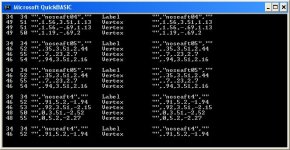Old Graphic Cards, and Qbasic does make good AFX!!
Hello Ivan,
Thank you for your helpful comments!
I´m very sorry to hear about your development computer,
but I believe I have some good news for you.
Please e-mail me your home address I will be only too glad to send you
a couple of cards that may be useful to you. They are looking for a new home!
I would air-mail them to you in a little package, declared for customs as used
old hardware with no monetary worth, which is the truth anyway! It would be
no trouble at all for me to do so, and I would insist on it.
I would only have to know which slot you need a card for: Legacy/ISA, PCI or AGP.
They are not super performers, but at least they will get your development machine
back into reasonable working order.
A good one I have is an 8Mb ISA slot Graphics card with elevated platform memory,
or a 4 Mb PCI Graphics card. The best one would probably be the 8Mb PCI graphics card.
This is the only one I actually bought - in 1997, and there are also a couple of
4 mb 2D/3D AGP slot graphics cards, as well as one or two 32 Mb AGP Accellerator cards.
Tomorrow I have to go to my father in law´s house, where all this old hardware is stored,
and I´ll bring all the cards here an send you pictures of them, so you can take your pick.
I also have the drivers for many of them...
All these cards were given to me over the years by friends or ex work-colleagues.
Re: MIDI port and/or Game port:
All the old sound cards I have, have 15-pin game ports, which I thought were
serial ports, where the FFB Sidewinder could be plugged into.
A newer one is a SoundBlaster with 5 jacks, not the usual 3.
I´ll bring it here tomorrow and send you a picture too.
Re: Qbasic: You are right! It does do what I´m trying.
Learning anything is not exactly a fast process - and I have just discovered
the solution to my Qbasic inverted comma predicament:
I already knew that QBasic has 2 different reading instructions:
INPUT, which uses inverted commas and commas as separators, and
LINE INPUT, which only uses commas as separatos, where Inverted Commas
are text symbols.
For writing files, the WRITE # instruction (which I was using) adds inverted
commas at the beginning and at the end, and it took me all this time to find
out that PRINT # writes to a file without adding the inverted commas!
Simply making a copy of the same file in Qbasic produces an AFX file, that
works perfectly well in AF99 !! Now I can continue working on the QBasic
versions of StretchIt and MoveIt.
Here´s 2 screenshots of partial views of the Qbasic programme result
I´m getting so far. I have it in Window mode so I can make a screenshot.
Normally I´d work in full-screen mode.
The programme identifies all part-labels and all vertices in the AFX.
The two numbers on the left are the ASCII symbols in the fourth and the last
positions in each line, to differentiate lines with vertices from lines with labels.
The duplicated column on the right is just to double-check that the resulting
isolated line is identical to the actual line in the original text file.
You can also see the structures, that have two labels - the first label contains
no vertices, but structure position and colour, unnecessary for now.
Oh dear...Another long post, but such is life when you are enjoying yourself.
Cheers,
Aleatorylamp










